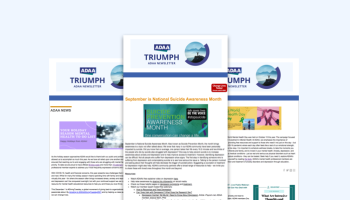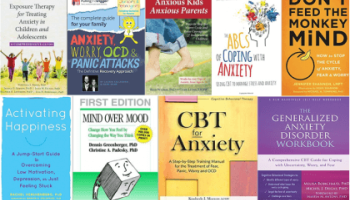Flipping the Script: When the Therapist Becomes the Patient
Flipping the Script: When the Therapist Becomes the Patient

As I was being discharged from the hospital after an 11-day stay, a friend texted me: “The hard part’s over!” In one sense she was correct – I’d completed the antibiotics for COVID, my sepsis was gone, and my pneumonia and kidney function were improving. But that was just the physical battle.
When I was in the emergency department and the doctor informed me of my diagnoses, I asked if I could go home to make arrangements for my dog Ritz and return to the hospital in a few hours. With disbelief in his eyes, the doctor said, “I don’t think you realize how sick you are.” After a short back-and-forth, I decided to stay and called a friend to care for Ritz.
Logically I understood that I’d been in the hospital with three very serious – potentially deadly – conditions. I knew that being hospitalized in isolation for 11 days isn’t minor. However, I still didn’t get it. Once I returned home and my friends and family started to admit how terrified they’d been during my hospitalization, it started to sink in, and I appreciated that what I’d experienced was a trauma.
A colleague and I once discussed the difference between Trauma (with a capital T, the formal diagnosis) and trauma (with a lowercase t). The capital T took its definition from DSM-5: directly experiencing, witnessing, or learning about actual or threatened death, serious injury, or sexual assault. The lowercase t we decided was an extremely upsetting or distressing experience.
Being hospitalized for three potentially fatal diagnoses was absolutely Trauma.
As I reviewed the diagnostic criteria for posttraumatic stress disorder, I came to an easy conclusion: I didn’t want to risk going down this path. It was then I decided I wanted to start therapy to preempt potential PTSD symptoms. I made this decision for several reasons:
1. Self-Care. As mental health clinicians we preach self-care to our patients, often using the analogy of being on an airplane that loses cabin pressure and putting the air mask on yourself before others. When patients balk at this, saying that caring for themselves is self-centered or selfish or narcissistic, I draw a two-circle Venn Diagram. In one circle I write selfish and in the other selfless. We talk about the difference being that selfish is taking into consideration only one’s own wants and needs and ignoring the impact on others. Selflessness accounts for what others need and ignores our needs to sustain ourselves. The overlap is where self-care falls. Self-care is the balance between taking care of ourselves while also being aware of others and doing our best to maintain a healthy equilibrium. As therapists, our job involves attending to our patients’ mental health needs, but as fulfilling as this role can be it’s also very demanding. If we’re not functioning at our best, there’s no way we can offer our patients the optimal care they deserve. My regular self-care includes playing with my dog, baking, calling or video chatting with long-distance friends, and reality TV. But when there are extraordinary circumstances, additional self-care efforts need to happen to maintain stability, and right now for me that means therapy.
2. Practice What I Preach. If I didn’t believe in the healing power of evidence-based therapy, I probably picked the wrong career. I encourage people to take their mental health as seriously as their physical health. In particular, I often point out that people are perfectly willing to take time out of their busy lives to see a medical doctor for an injured foot, but will cancel therapy appointments because it’s not seen as important. Whether it’s the stigma of mental health care or the idea that if it’s not visible it’s not serious, mental health is almost regarded as a luxury rather than a necessity for optimal functioning, and even then only once other areas of life are affected, such as work, school, or relationships. If I honestly believe in the importance of evidence-based mental health treatment, then it’s critical that I head off the possibility of a severe problem, make my mental health a priority, and go to therapy with a trauma specialist.
3. Therapists Aren’t Exempt from Problems. When I told a few close friends and family members that I was going to start therapy, I was surprised how many were caught off-guard by my decision. I heard everything from “But you’re a good therapist” to “What can someone else do that you don’t already know?” to “Are you going to give up your practice?” The simple fact is that along with being a daughter, niece, friend, therapist, dog mom, baker, and so many other roles, what always remains true is that I’m human. The old adage that a lawyer who represents himself has a fool for a client rings very true. One of the best features of seeing a therapist is that someone with a little distance can offer a perspective without bias. Even as a skilled therapist, I might not be the best person to identify my own patterns or thinking errors – having an outsider support me in improving myself and addressing my problems not only makes me a better human, but a better therapist.
4. Living My Best Life. One of the silver linings of the coronavirus pandemic has been realizing that not only can we live without many of our normal conveniences, but our relationships are more important and deserve more time than we typically give them. Since mid-March, when my “stay-at-home” started, I’ve had more video calls with distant family members and loved ones, as well as local friends I’m missing due to social distancing. Spending more time “with” these wonderful people and receiving their love and support through my COVID ordeal reinforces their importance in my life. Several years ago, I adopted a phrase to help me stop sweating the small stuff. When something goes wrong or turns out as less-than-ideal, I say – sometimes to myself, and other times out loud – “May this be the worst thing that happens to me today.” If my dry cleaning isn’t ready on time or the supermarket is out of an ingredient I need for dinner and these are my biggest concerns in life, then I’m pretty lucky. This phrase injects an attitude of gratitude into my life, as well as a reality check about the insignificance of many of life’s daily obstacles. By keeping an accurate perspective of the things going on in my life, I’m better able to thrive and live my best life.
After a few weeks of treatment, my therapist asked me where I thought I was in terms of processing my trauma. I said I was still in my apartment most of the time, and when I leave it’s wearing a mask and gloves with social distancing. I spend the majority of my time doing teletherapy sessions with my patients, reading books, and taking care of my dog. I’m not reading or watching anything related to COVID. She asked for my thinking behind this. I don’t deny the seriousness of the pandemic or the impact it’s had on individuals, the economy, and businesses, but I also don’t think it enhances my life to inundate myself with news about the virus. New and noteworthy information on COVID is limited, and the rest is only repetition of the same negativity. Unlike someone with an anxiety disorder or obsessive-compulsive disorder who practices avoidance as a ritual, I’m choosing not to engage. I don’t turn my head away from newsstands or watch only TV channels that don’t offer news. I don’t have a visceral reaction to the word “coronavirus.” And if I’m chatting with a friend and they bring it up, I don’t shut down or demand a change in topic.
Simply put, I not only desire to live my best life, I’m choosing to do so. And, for now, one of the ways I’m doing that is by taking care of myself and having therapy.












